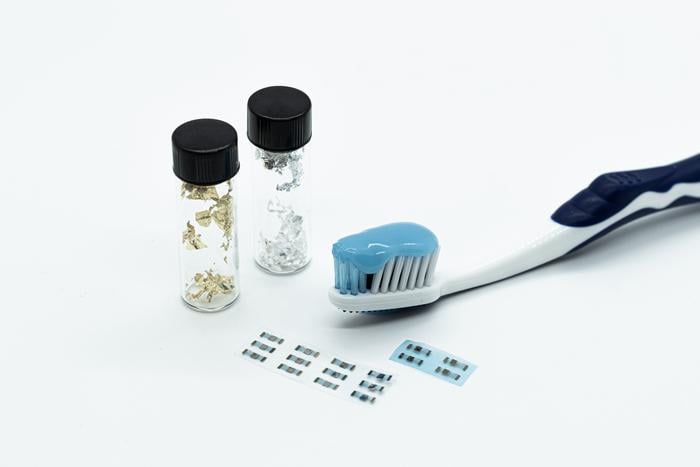Researchers at the Istituto Italiano di Tecnologia have created a transistor using a common toothpaste ingredient, paving the way for ingestible electronic devices to monitor health from inside the body.
Summary: Scientists have developed a transistor using copper phthalocyanine, a pigment found in toothpaste, advancing the field of edible electronics for potential use in smart pills and health monitoring.
Estimated reading time: 4 minutes
In a remarkable fusion of dental hygiene and cutting-edge technology, researchers at the Istituto Italiano di Tecnologia (IIT) in Milan have developed a transistor using a common toothpaste ingredient. This innovation marks a significant step forward in the field of edible electronics, with potential applications in health monitoring and smart pill technology.
The study, published in the journal Advanced Science, focuses on copper phthalocyanine, a blue pigment used as a whitening agent in many commercial toothpastes. This substance, which we unknowingly ingest daily, has proven to be a promising semiconductor for edible electronic devices.
From Toothbrush to Transistor
Elena Feltri, the paper’s lead author and a doctoral student at IIT’s Center for Nano Science and Technology (CNST) in Milan, explains the potential of this discovery: “With the amount of copper phthalocyanine we ingest daily, we could theoretically manufacture approximately 10,000 edible transistors.”
The research team’s approach is both innovative and practical. They’ve utilized a substance that, while not officially regulated for intentional ingestion, is already consumed safely by millions of people every day. This strategy opens up new possibilities for edible electronics without introducing unfamiliar substances into the human body.
The Science Behind the Smile
Copper phthalocyanine’s journey from toothpaste to transistor is rooted in its unique chemical structure. The pigment’s crystals facilitate charge conduction, making it an excellent semiconductor for organic electronics applications.
To create the edible transistor, the team integrated small amounts of copper phthalocyanine into an existing recipe for edible circuits. The device is built on an ethylcellulose substrate, with electrical contacts printed using inkjet technology and a solution of gold particles – a material already used in culinary decoration.
A key component of the transistor is its “gate,” made from an electrolytic gel based on chitosan, a food-grade gelling agent derived from crustacean shells. This design allows the transistor to operate at a low voltage of less than 1V, making it safe for potential in-body use.
Implications for Healthcare and Beyond
The development of this edible transistor is more than just a scientific curiosity. It represents a crucial step towards creating fully functional edible electronic systems that could revolutionize healthcare monitoring and diagnostics.
Potential applications include:
- Smart pills that can monitor health conditions from within the body
- Ingestible sensors to track medication efficacy and adherence
- Temporary electronic implants that dissolve after completing their function
The research team, led by Mario Caironi at the Printed and Molecular Electronics laboratory, is at the forefront of exploring food electronics. This work builds on their previous invention of an edible battery and is part of broader initiatives like the ELFO project and the European RoboFood project, which aims to develop edible robots.
Looking Ahead: Challenges and Opportunities
While the toothpaste-based transistor represents a significant advance, several questions remain:
- How will these devices be powered safely within the body?
- What are the long-term effects of ingesting electronic components, even if they’re made from food-grade materials?
- How can data be transmitted safely and effectively from inside the body?
The research team is already looking ahead to identify other edible substances with suitable properties for creating intelligent, edible electronic devices for healthcare applications. Their goal is to develop systems capable of monitoring various body parameters within the gastrointestinal tract.
As this field progresses, it promises to open new frontiers in personalized medicine and non-invasive diagnostics. The future of healthcare might just begin with your morning brush.
Quiz
- What is the main ingredient from toothpaste used in the edible transistor? a) Fluoride b) Copper phthalocyanine c) Sodium bicarbonate
- Approximately how many edible transistors could be made from the daily ingested amount of this ingredient? a) 100 b) 1,000 c) 10,000
- What is the voltage at which this edible transistor operates? a) Less than 1V b) 5V c) 12V
Answers:
- b) Copper phthalocyanine
- c) 10,000
- a) Less than 1V
Further Reading
- Advanced Science Journal: A Fully Edible Transistor Based on a Toothpaste Pigment
Glossary of Terms
- Edible electronics: Electronic devices designed to be safely ingested and used within the human body.
- Copper phthalocyanine: A blue pigment used in toothpaste as a whitening agent, which also functions as a semiconductor.
- Transistor: A fundamental component in electronics that can amplify or switch electronic signals.
- Semiconductor: A material with electrical conductivity between that of a conductor and an insulator.
- Ethylcellulose: A cellulose derivative used as a substrate in edible electronics.
- Chitosan: A food-grade gelling agent derived from crustacean shells, used in the transistor’s “gate” component.
Enjoy this story? Get our newsletter! https://scienceblog.substack.com


